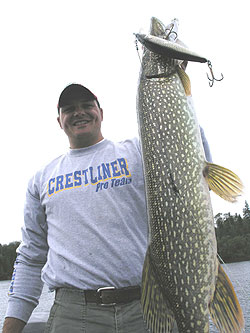 Stop at your favorite tackle shop and watch for a few minutes. It won’t take long for a customer to wander into the crankbait aisle looking for a certain bait to fill the void in their tacklebox and the empty space in their heart. Bending to one knee, the customer moves a finger along several lure boxes, eventually pulling one from a display hook, scanning the words scripted on the back of the package and smiling as they approach the checkout. This is the one.
Stop at your favorite tackle shop and watch for a few minutes. It won’t take long for a customer to wander into the crankbait aisle looking for a certain bait to fill the void in their tacklebox and the empty space in their heart. Bending to one knee, the customer moves a finger along several lure boxes, eventually pulling one from a display hook, scanning the words scripted on the back of the package and smiling as they approach the checkout. This is the one.
Crankbaits work in many situations and are fairly simple to use. Starting a relationship with a crankbait isn’t difficult, but does require a certain level of devotion. Using a wobbler, jerk bait or glider for a couple casts a week simply isn’t enough. If you dedicate yourself to using a crankbait for longer periods of time, you’ll gain a greater understanding of its abilities.
Exchanging Vows
Purchasing a crankbait doesn’t typically entail a lifetime commitment. But Salmo Lures, based in Poland, believes it should be and warranties their baits for life (excluding the hooks and rings). The interior and exterior composition of these crankbaits is so superior, they’re willing to back it up with a warranty that ensures a life-long, high-performance fishing partner.
But this is not an unbalanced relationship. Your crankbait has some expectations for you too. First off, you should treat it right. Store it in a dry place, because even though it loves water, prolonged exposure to moisture will make the hooks and rings rust. And second, a crankbait wants to feel loved. Promise to take it out every weekend!
 With this Ring
With this Ring
The rings of a lure are one of the most important, yet routinely overlooked components, an unfaithful act in the relationship with your crankbait. Although not standard on all crankbaits, the front ring available for attaching your main line is an important element, since it allows the crankbait to sway freely. But tie your line to the eye ring in an inappropriate position and your crankbait may come untied, leaving you without explanation or a farewell letter. It’s best to tie your monofilament, fluorocarbon or braided line on the single bar of the split ring, enabling a snug knot. However, a Duncan loop also works well because this open knot allows the bait to sway uninhibited. Steel leaders become an asset when searching for toothy species like northern pike and muskie.
The hook rings are equally important and should be given some periodic attention. Replace them if any rust appears and also if they remain open, a tragedy waiting to take place. A good pair of split ring pliers makes this task simple to perform.
For Better or for Worse
Crankbaits work well for a variety of different species because of a few simple principles. First of all, a crankbait has the appearance of various prey targets including but not limited to smelt, shad, shiners, goby, perch, sunfish, crayfish, cisco, and practically any minnow or fish that swims in freshwater. Second, a crankbait has a visually appealing action that emulates an injured minnow or fleeing crayfish, the ideal fare for a hungry predator. And third, the vibration created by a shaking crankbait positively impacts a fish’s ability to locate the lure using auditory receptors.
‘Til Depth Do Us Part
Many factors affect the diving depth of a crankbait. Even though most manufacturers display a maximum diving depth on their packaging, numerous variables impact a crankbaits plunging capabilities, such as line weight, line composition (braid, monofilament, leadcore), and amount of line released. Years can be dedicated to discovering how various crankbaits perform by varying these impacting factors, but the easiest way to figure it out is to read Precision Trolling and Precision Casting, two books written by Mark Romanack that take the guesswork out of understanding crankbait diving depth. And who couldn’t use some help in understanding their partner a little better?










